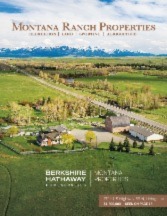
Rod Freeman
Sales Associate, GRI
C: 406.369.0320 O: 406.375.0166
Email Website
120 South 5th Street
Suite 201
O: 406.375.0166 F: 406.375.0165


Sales Associate, GRI
C: 406.369.0320 O: 406.375.0166
Email Website
120 South 5th Street
Suite 201
O: 406.375.0166 F: 406.375.0165

Ranchers and farmers are excellent stewards of their land and as a result, are constantly seeking new and improved methods of providing quality feed to their livestock without the need for fertilizing or weed control. The method that has grown in application and in success is the managed intensive grazing system, a method that goes by other names, such as the rotational pasture system. The concept is can most simply be defined as a system that places a large concentration of animals in a small pasture for a very short period of time.
I was fortunate enough to tour the La Cense Ranch in Dillon to see their system in action. The La Cense team has 3500 acres under pivot irrigation. They have the capacity with this system to feed 8-10,000 stocker calves. The land is divided into five-acre parcels and they rotate 500 cattle through each pasture every 24 hours. The goal is to have the grass reach 13 inches in height and that it be grazed down to no shorter than 4 inches. The pastures are defined primarily by hot wire and it takes one hand 8 minutes to move the herd to the new pasture with the hot wire installed. I saw it happen!
The ranch keeps accurate records year around to include tracking the gains of the cattle. The average daily gain is 3.2 pounds.
The pastures benefit in several ways, the concentration of cattle spreads manure fairly evenly eliminating the need for fertilizer while actually increasing soil fertility. Weeds do not compete well with the healthy grasses that remain to eliminate the need for weed control. Parasite control is enhanced as the worms are left in each pasture and die before the cattle return.
The La Cense ranch feeds their stocker cattle via this method for the growing season and then off to market they go. The ranch does still run 2500 cow calf pair that they rotate through grazing pastures all year long. The range cattle rotations are not as intently managed as the stocker cattle but the results speak for themselves, resulting in healthier grazing pastures with many of the same benefits as they achieve with the intensely managed system.
Another major benefit of the system is the elimination of the need for hay production and thus the huge expense of the equipment and man hours involved in that effort.
Obviously, the La Cense ranch has the advantage of a large acreage ranch with a significant section available for the use pivot irrigation systems all connectable with all of the utility resources needed. That does not make a variation of managed intensive grazing a viable system for livestock operations in general and it is certainly not limited to cattle.
Rod Freeman
Montana Ranch Properties
Ravalli County Fairboard
